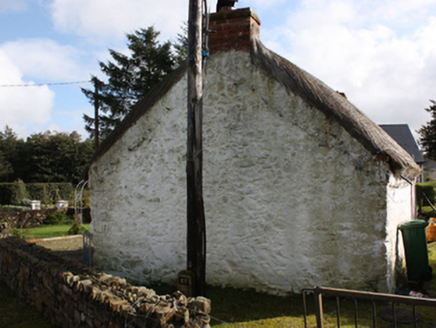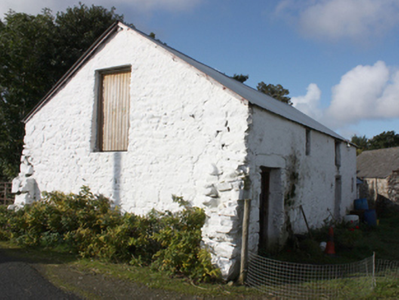Survey Data
Reg No
40805007
Rating
Regional
Categories of Special Interest
Architectural, Technical
Original Use
House
In Use As
House
Date
1800 - 1880
Coordinates
247220, 445899
Date Recorded
08/10/2008
Date Updated
--/--/--
Description
Detached four-bay single-storey vernacular house, built c. 1820 and extended c. 1860, having projecting entrance porch offset to the west side of the main elevation (north-east). Pitched thatched roof with rounded ridge, two red brick chimneystacks (on to the north-west gable end and one offset to the south-east side centre), and with ropes over secured on metal pegs with wrought-iron bar below eaves level. Whitewashed rubble walls. Square-headed window openings with two-over-two pane timber sliding sash windows and stone sills. Square-headed door opening to windbreak porch having replacement battened timber door. Set back from road in own grounds to the north of the centre of Carndonagh. Rubble stone boundary walls to north and north-west of site. Former mill race running immediately to rear of property (south). Detached four-bay two-storey outbuilding to the north-west of site having corrugated-metal roof, rubble stone walls, and square-headed openings with timber fittings. Detached single-storey outbuilding or former threshing mill to the north-west of site having pitched natural slate roof, rubble stone walls, and square-headed openings.
Appraisal
This charming and well-maintained thatched vernacular house, of probable early nineteenth-century date, retains its early form and character, and is an appealing feature in the landscape to the north of Carndonagh. Its architectural integrity and visual expression is enhanced by the retention of the majority of its salient fabric, including timber sliding sash windows. Modest in scale, it exhibits the simple and functional form of vernacular building in Ireland. Of particular interest in the survival of the thatch roof, which is now sadly becoming increasingly rare in Donegal. The rounded roof is a typical feature of thatched houses located close to the sea in exposed areas in the north-west of Ireland, while the metal pegs to the eaves were\are used to tie ropes (and sometimes nets) over the roof to secure it against the prevailing winds, as is the case in this particular example. The largely blank rear elevation is a typical feature of many small-scale vernacular dwellings in rural Ireland. The form of this building and location of the chimneystacks suggests that this building is of the ‘direct entry’ type that is characteristic of the vernacular tradition in north-west Ireland, and also suggests that this building was extended to the south-east by a bay at some stage, probably during the second half of the nineteenth-century. The substantial two-storey rubble stone outbuilding to site adds considerably the setting and context of this dwelling, and is an interesting vernacular survival in its own right. The single-storey outbuilding to the north-west of site also survives in good condition and may be a former corn threshing mill (Ordnance Survey twenty-five inch map of c. 1900). The arrangement of outbuildings\former dwellings and a further vernacular house with thatched roof in the immediate vicinity to the north-west (see 40805008) suggests that it formed part of a small nucleating settlement or clachan. This house and ancillary structures represent a fine surviving example of a once ubiquitous building type in the rural Irish countryside, and is one of the better and more attractive surviving examples of its type in County Donegal.













